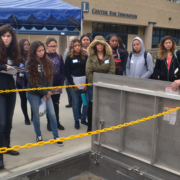A flood of water industry professionals nearing retirement has prompted local agencies to form a task force charged with assessing ways to develop the water workforce of the future. Education leaders are stepping up outreach to fill their career training programs, and water agencies are looking for new ways to attract employees.
“For many years now, we’ve been talking about the ‘Silver Tsunami’ of aging baby boomers who are going to be leaving the workforce, but it really is coming to fruition now,” said Don Jones, who helped spearhead Cuyamaca College’s new Center for Water Studies housing the college’s Water & Wastewater Technology program. “Almost one-third of water industry professionals will be at or nearing retirement age in the next few years. When you combine that with the fact that the unemployment rate is already at record or near-record lows and other industries are facing the same challenges and going after the same people we are, we have some serious work to do.”
Those concerns have spurred the San Diego County Water Authority and other agencies to convene a regional task force comprising utility directors and general managers, which has been meeting for months to assess workforce-related challenges, collect and analyze employment data, and craft a plan for moving forward.
Water industry offers competitive salaries

Approximately 40 percent of the Fallbrook Public Utility District ‘s 68 employees will be eligible to retire within five years. Seventeen percent are currently eligible for retirement. Photo: Fallbrook PUD
The regional water and wastewater industry expects to need to fill approximately 400 positions annually to keep pace with retirements and vacancies caused by employees leaving the area.
The challenges face both large and small agencies. In the City of San Diego, 640 of approximately 1,600 water industry professionals will be eligible to retire within the next three to four years. At the Fallbrook Public Utility District approximately 40 percent of the agency’s 68 employees will be eligible to retire within five years. Seventeen percent are currently eligible for retirement.
“These are good-paying jobs with good benefits, but you just don’t find a lot of people coming out of school who are interested, and we are struggling to attract skilled employees from the private sector,” said Jack Bebee, Fallbrook general manager.
Bebee pointed to the recent posting of a senior engineering position at the utility that pays an annual salary of close to $150,000. The district thought the salary would be competitive enough to draw people from the private sector, but only one of four applicants was from the private sector. When Bebee was hired for a similar position nine years ago, he competed against 40 other applicants.
A 2018 Brookings Institution report notes the employment void exists even though water workforce occupations not only pay more on average compared to all occupations nationally, but also pay up to 50 percent more to workers at the lower ends of the income scale. In San Diego County, water and wastewater plant and systems operators are earning an average salary of $70,000 annually, according to the U.S. Bureau of Labor Statistics.
Skilled workers needed to operate increasingly complex systems
While the Bureau of Labor Statistics notes that fewer people may be needed in coming years as water and wastewater plants become more automated, a skilled workforce is required to operate increasingly complex controls and systems. Some of the most advanced facilities in the world are in Southern California, including the Claude “Bud” Lewis Carlsbad Desalination Plant, the naton’s largest desalination plant.
Local educational efforts in the industry are addressing the potential worker shortage:
- Palomar College’s Water and Wastewater Technology programs, provides pre-employment training and advanced courses for people who want to become certified as a water or wastewater operator.
- The Water Authority’s student internship program pays $12 an hour and has interns working at four different water agencies throughout the year.
- California State University, San Marcos Certificate in Water Management & Leadership program is geared toward workers already employed as intermediate-level supervisors in the water industry and offers training and skills needed for higher management positions.
- The Center for Water Studies at Cuyamaca College.
The Brookings report noted the glut of retirements offers an opportunity to diversify the industry. In January, the Center for Water Studies held the first in an annual series of Women in Water symposiums, attracting several hundred women and high school girls from throughout Southern California interested in a new career.
“Challenges can prompt people to get together and look at new ways of doing things,” said Greg Thomas, general manager at the Rincon del Diablo Municipal Water District in Escondido. “This is a great industry, it pays well, and you’re doing something good for people and society.”








